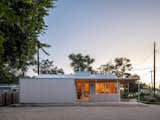Credits
From Tim Derrington
In Austin’s Montopolis neighborhood, Derrington Building Studio built its own home base: a compact 1,000-square-foot structure that quietly blends into a modest mid-century residential fabric. Designed and constructed entirely by the studio, the building reflects a philosophy of finding elegance in constraint and meaning in raw, honest materials.
The studio’s dual purpose shaped every decision. It serves as a professional workspace today, with two main rooms, a bathroom, and a kitchenette organized for efficient daily use, but it was conceived to transition easily into a residence in the future. A deep porch, covered outdoor sink, and integrated raised flower bed extend daily life outside, framing the small structure with approachable gestures that connect to both garden and street.
Rather than rely on typical cavity-wall construction, the project turns conventional practice inside out. By insulating the exterior with polyiso panels, the interior framing remains fully exposed—a deliberate move that transforms structure into finish. This strategy reduces hidden maintenance issues, encourages direct engagement with the building’s anatomy, and creates interiors inspired by Japanese, Scandinavian, and Alpine timber traditions, filtered through American industrial pragmatism. Every screw, nail, and plywood panel is considered, visible, and celebrated.
The exterior is clad in Galvalume siding, chosen as much for performance as cultural resonance. Durable and low-maintenance, it reflects Texas heat while recalling rural vernacular buildings across the state. The form—a simple gable—mirrors the scale of neighboring houses built between the 1950s and 1970s, allowing the studio to sit comfortably among them without pretense.
The result is a modest building that feels both timeless and specific, balancing practicality and quiet beauty. For Derrington Building Studio, this project embodies their guiding principle: a path of less resistance. Not less effort, but less friction—an approach where honest materials and thoughtful restraint lead to architecture that’s enduring, adaptable, and deeply rooted in its place.



















